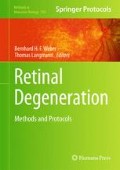Abstract
The identification of stem/progenitor cells within the retinal neural environment has opened up the possibility of therapy via cellular replacement and/or reprogramming of resident cell populations (1–4). Within the neuro-retinal niche, following injury or in disease states (including inflammation and degeneration), cellular responses affect tissue homeostasis, reduce cell density, disrupt tissue architecture, and produce scar formation. Microglia (resident retinal immune cell tissue macrophage) are key to the maintenance of retinal homeostasis and are implicated in responses that may influence the control and behavior of retinal progenitors (5, 6). Factors to consider in the generation of a transplantable cell resource with good migratory and integrative capacity include their yield, purity, and functional viability. Utilizing human postmortem retina, we have created a research platform to isolate, culture, and characterize adult retinal microglia as well as analyze their effect on retinal progenitors. Here, we describe techniques using magnetic labeled bead cell separation to isolate pure populations of retinal CD133+ precursor cells and CD11b+ microglia from primary adult retinal cell suspensions (RCSs), enabling flow cytometric cell phenotypic and qPCR genotypic analysis, as well as functional analysis by real-time ratiometric calcium imaging.
Access this chapter
Tax calculation will be finalised at checkout
Purchases are for personal use only
References
Ahmad I, Tang L, Pham H (2000) Identification of neural progenitors in the adult mammalian eye. Biochem Biophys Res Commun 270:517–521
Tropepe V, Coles BL, Chiasson BJ, Horsford DJ, Elia AJ, McInnes RR, van der Kooy D (2000) Retinal stem cells in the adult mammalian eye. Science 287:2032–2036
Coles BL, Angenieux B, Inoue T, Del Rio-Tsonis K, Spence JR, McInnes RR, Arsenijevic Y, van der Kooy D (2004) Facile isolation and the characterization of human retinal stem cells. Proc Natl Acad Sci U S A 101:15772–15777
Mayer EJ, Carter DA, Ren Y, Hughes EH, Rice CM, Halfpenny CA, Scolding NJ, Dick AD (2005) Neural progenitor cells from postmortem adult human retina. Br J Ophthalmol 89:102–106
Mayer EJ, Balasubramaniam B, Carter DA, Dick AD (2009) Retinal progenitor cells in regeneration and repair highlight new therapeutic targets. Eur Ophthalmol Rev 3:75–80
Dick AD (2009) Influence of microglia on retinal progenitor cell turnover and cell replacement. Eye 23:1939–1945
Corti S, Nizzardo M, Nardini M, Donadoni C, Locatelli F, Papadimitriou D et al (2007) Isolation and characterization of murine neural stem/progenitor cells based on Prominin-1 expression. Exp Neurol 205:547–562
Carter DA, Dick AD, Mayer EJ (2009) CD133+ adult human retinal cells remain undifferentiated in leukaemia inhibitory factor (LIF). BMC Ophthalmol 9:1
Balasubramaniam B, Carter DA, Mayer EJ, Dick AD (2009) Microglia derived IL-6 suppresses neurosphere generation from adult human retinal cell suspensions. Exp Eye Res 89:757–766
Grynkiewicz G, Poenie M, Tsien RY (1985) A new generation of Ca2+ indicators with greatly improved fluorescence properties. J Biol Chem 260:3440–3450
Barreto-Chang OL, Dolmetsch RE (2009) Calcium imaging of cortical neurons using Fura-2AM. J Vis Exp 23:1067. doi:10.3791/1067, http://www.jove.com/details.stp?id=1067
Nicholson E, Balasubramaniam B, Carrick T, Miller S, Kouranova E, Saraf K, von Schack D, Ring R, Whiteside G, Dick AD, Randall AD (2011) Histamine H1 receptors activate human microglia. AJP Cell Phys
Acknowledgments
This work was supported by grants from Guide Dogs for the Blind (Dr Debra Carter) and The Dr Hans and Mrs Gertrude Hirsch Studentship via the National Eye Research Council (NERC), UK (Balini Balasubramaniam). We are grateful to the Bristol Eye bank team, and most of all to the tissue donors and their families.
Author information
Authors and Affiliations
Corresponding author
Editor information
Editors and Affiliations
Rights and permissions
Copyright information
© 2012 Springer Science+Business Media, LLC
About this protocol
Cite this protocol
Carter, D.A., Balasubramaniam, B., Dick, A.D. (2012). Functional Analysis of Retinal Microglia and Their Effects on Progenitors. In: Weber, B., LANGMANN, T. (eds) Retinal Degeneration. Methods in Molecular Biology, vol 935. Humana Press, Totowa, NJ. https://doi.org/10.1007/978-1-62703-080-9_19
Download citation
DOI: https://doi.org/10.1007/978-1-62703-080-9_19
Published:
Publisher Name: Humana Press, Totowa, NJ
Print ISBN: 978-1-62703-079-3
Online ISBN: 978-1-62703-080-9
eBook Packages: Springer Protocols

